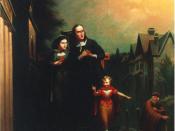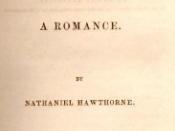In Hawthorne's "The Scarlet Letter", the quote "No man, for any considerable period, can wear one face to himself, and another to the multitude, without finally getting bewildered as to which may be true." stands true in many forms. Both Hester Prynne and Arthur Dimmesdale, prominent characters in the novel, convey this two-faced nature in the countenance of an overbearing Puritan society. It is this inner conflict, existing within all humans, that eventually brings about the downfall of these characters and to a large degree sheds light upon the human condition.
Dimmesdale, the personification of "human frailty and sorrow," is young, pale, and physically delicate. An ordained Puritan minister, he is well educated, and he has a philosophical turn of mind. There is no doubt that he is devoted to God, passionate in his religion, and effective in the pulpit. He also has the principal conflict in the novel, and his agonized suffering is the direct result of his inability to disclose his sin.
In Puritan terms, Dimmesdale's predicament is that he is unsure of his soul's status: He is exemplary in performing his duties as a Puritan minister, an indicator that he is one of the elect; however, he knows he has sinned and considers himself a hypocrite, a sign he is not chosen.
Dimmesdale's struggle is dark and his penance is horrifying as he tries to unravel his mystery. He struggles with his knowledge of his sin, his inability to disclose it to Puritan society, and his desire for penance. He knows his actions have fallen short of both God's standards and his own, and he fears this represents his lack of salvation. In an attempt to seek salvation, he fasts until he faints and whips himself on the shoulders until he bleeds. But these...


